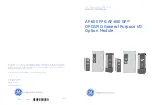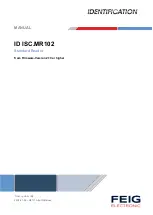
iSMA-B-MINI/MIX BACnet User Manual
www.ismacontrolli.com
DMP261en | 1st Issue rev. 8 | 05/2022
page 11 of 114
•
•
•
•
•
•
•
•
2.1 Wiring
In most cases, I/O modules will be installed in an enclosure along with the other devices,
which generate electromagnetic radiation. Relays, contactors, transformers, motor
invertors, etc., are examples of such devices. Radiation can induce electrical noise into
both power and signal lines, as well as direct radiation into the module. Whether or not
the iSMA modules are immune to such effects, the interferences must be suppressed at
their source if possible to ensure the proper functioning of the entire system.
Appropriate grounding, shielding and other protective steps should be taken at the
installation stage to prevent these effects. It is recommended to at least follow the rules
below:
Line power cables must be routed with spatial separation from signal and data
transmission cables.
Analog and digital signal cables should also be separated.
It is recommended to use shielded cables for analog signals, cable shields should not
be interrupted by intermediate terminals.
The shielding should be earthed directly after the cable enters the cabinet.
It is recommended to install interference suppressors when switching inductive loads
(e.g., coils of contactors, relays, solenoid valves). RC snubbers or varistors are suitable for
AC voltage and freewheeling diodes for DC voltage loads. The suppressing elements must
be connected as close to the coil as possible.
2.2 EN 60730-1 Power Supply Considerations
Electrical safety in the building automation and control systems is essentially based on
the use of extra-low voltage which is strictly separated from the mains voltage. This low
voltage is either SELV or PELV according to EN 60730-1.
Protection against electric shock is ensured by the following measures:
Limitation of voltage (low voltage AC/DC 24V supply, either SELV or PELV)
Protective-separation of the SELV-system from all circuits other than SELV and
PELV
Simple-separation of the SELV-system from other SELV-systems, from PELV-
systems and earth
Field devices such as sensors, status contacts, and actuators connected to the low-
voltage inputs and outputs of I/O modules must comply with the requirements for
SELV or PELV. The interfaces of field devices and other systems must also satisfy SELV
or PELV requirements.
If the supply of SELV or PELV circuits is obtained from supply mains of higher voltages,
it shall be provided by safety transformer or a converter designed for continuous
operation to supply SELV or PELV circuits.
2.3 FCC Compliance Note
Note:
This equipment has been tested and found to comply with the limits for a Class B
digital device, pursuant to part 15 of the FCC Rules. These limits are designed to provide
reasonable protection against harmful interference in a residential installation. This
equipment generates, uses and can radiate radio frequency energy and, if not installed
and used in accordance with the instructions, may cause harmful interference to radio
communications. However, there is no guarantee that interference will not occur in a












































